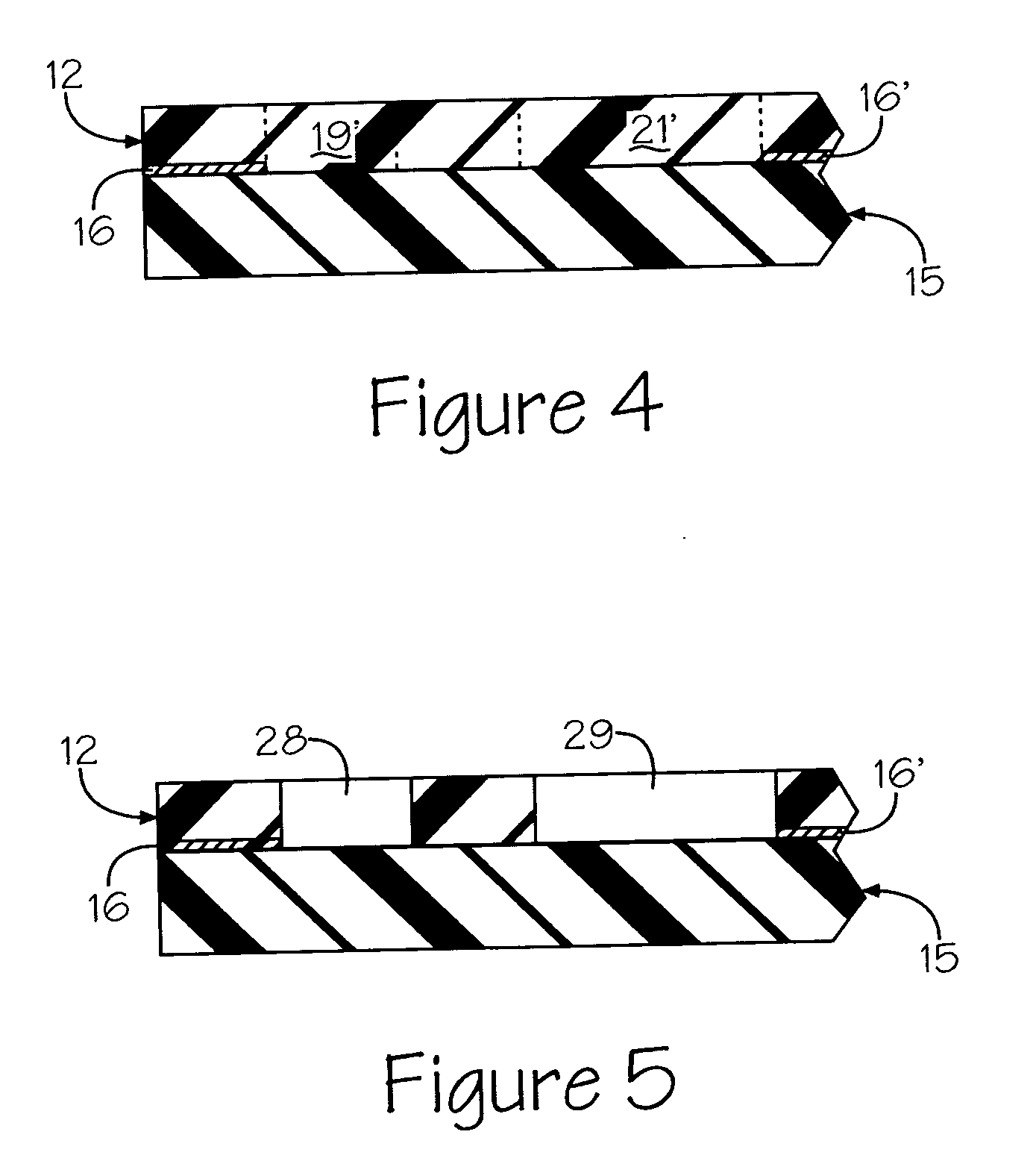Photosensitive dielectric film
a dielectric film and photosensitive technology, applied in the field of circuitized substrates, can solve the problems of high stress on the thermal cycling operation of the interconnection of semiconductor chip arrays to organic chip carriers, the complexity of such circuitized substrates as defined herein, and the inability of many known commercial procedures to economically form the dimensions desired by,
- Summary
- Abstract
- Description
- Claims
- Application Information
AI Technical Summary
Benefits of technology
Problems solved by technology
Method used
Image
Examples
example i
[0097]A composition is prepared having about 65.5 grams (gr) of PKHC from Phenoxy Associates, 76 gr of ERL-4221 from Union Carbide, 54.0 gr of Epon SU-8 from Hexion, 102 gr of Epon-1183 also from Hexion, 3.5 gr of UVI-6974 from Union Carbide and 0.06 phr of Ethyl Violet from Aldrich. The solvent content consisting of methyl ethyl ketone, diethylene glycol monomethyl ether acetate, propylene glycol monomethyl ether acetate or combinations is typically greater than 30% and sufficient to provide a composition that is coated on a carrier film using a slot die coating method.
[0098]The solvent based composition is coated onto a 1.5 mil thick polyester film “Mylar D” from DuPont using a roll to roll coater and dried at 130 degrees C. for about five minutes to provide a 2.2 mil thick coating on the polyester carrier. The film was subsequently used in fabricating a circuitized substrate test vehicle utilizing a hot roll laminator to place onto a substrate and subsequently processed using nor...
example ii
[0099]A composition is prepared having about 50.4 gr of PKHC from Phenoxy Associates, 81 gr of ERL-4221 from Union Carbide, 42.8 gr of Epon SU-8 from Hexion, 74.5 gr of Epon-1183 also from Hexion, 2.7 gr of UVI-6974 from Union Carbide, 0.045 phr of phthalocyanine green from Aldrich and 284 gr of spherical silica CE Minerals (Teco-sil 20). The solvent content consisting of methyl ethyl ketone, diethylene glycol monomethyl ether acetate, propylene glycol monomethyl ether acetate or combinations is typically greater than 30% and sufficient to provide a composition that is coatable onto a carrier film. The composition was thoroughly mixed using a ceramic ball mill apparatus to produce a very well homogeneous mixture having no silica agglomerates. The photosensitive composition is coated onto a 1.5 mil thick polyester film “Mylar D” from DuPont. The composition is baked at 130 degrees C. for 5 minutes to provide a 2.3 mil thick coating on the polyester carrier. The film is subsequently h...
example iii
[0100]A photosensitive composition is prepared having about 33.4 gr of PKHC from Phenoxy Associates, 79 gr of ERL-4221 from Union Carbide, 56.0 gr of Epon SU-8 from Hexion, 100 gr of Epon-1183 also from Hexion, 3.6 phr of UVI-6974 from Union Carbide, 0.2 phr of and 349 gr of silica. The solvent content comprising methyl ethyl ketone, diethylene glycol monomethyl ether acetate, propylene glycol monomethyl ether acetate or combinations is greater than 30% and sufficient to provide a composition that is coatable onto a carrier film. The composition is then coated onto a 1.5 mil thick polyester film “Mylar D” from DuPont. The photosensitive composition is baked at 130 degrees C. for 5 minutes to provide a 2.6 mil thick coating on the polyester carrier. The film is subsequently hot roll laminated onto a planar substrate used in evaluation of fabrication a circuitized test pattern panel and imaged by exposing it to 1200 jm / cm2 ultraviolet light. The panel was then baked at about 95-100 de...
PUM
| Property | Measurement | Unit |
|---|---|---|
| size | aaaaa | aaaaa |
| thickness | aaaaa | aaaaa |
| diameter | aaaaa | aaaaa |
Abstract
Description
Claims
Application Information
 Login to View More
Login to View More - R&D
- Intellectual Property
- Life Sciences
- Materials
- Tech Scout
- Unparalleled Data Quality
- Higher Quality Content
- 60% Fewer Hallucinations
Browse by: Latest US Patents, China's latest patents, Technical Efficacy Thesaurus, Application Domain, Technology Topic, Popular Technical Reports.
© 2025 PatSnap. All rights reserved.Legal|Privacy policy|Modern Slavery Act Transparency Statement|Sitemap|About US| Contact US: help@patsnap.com



